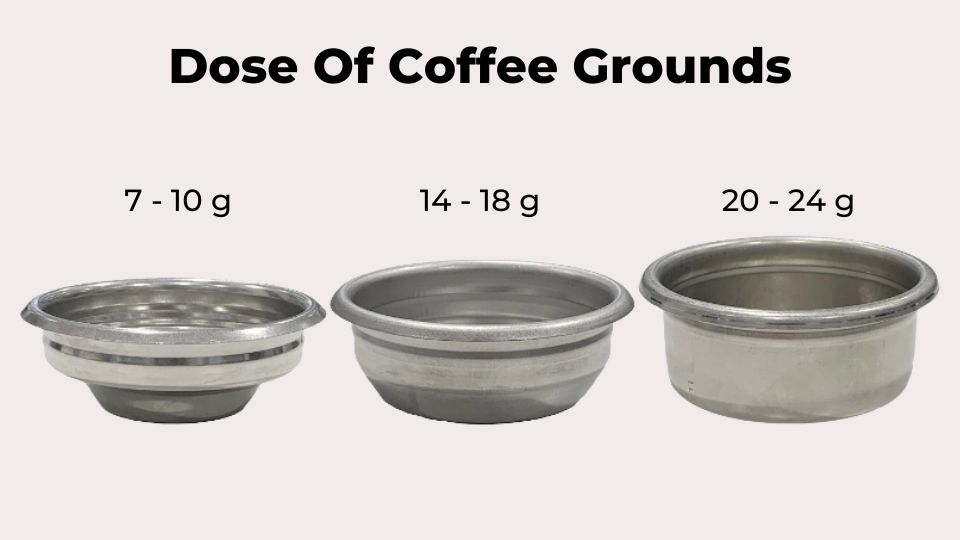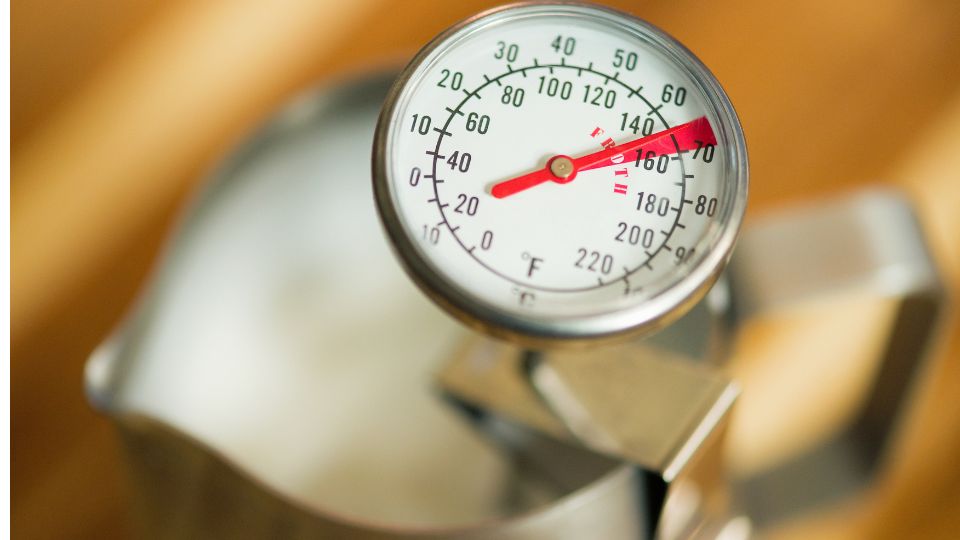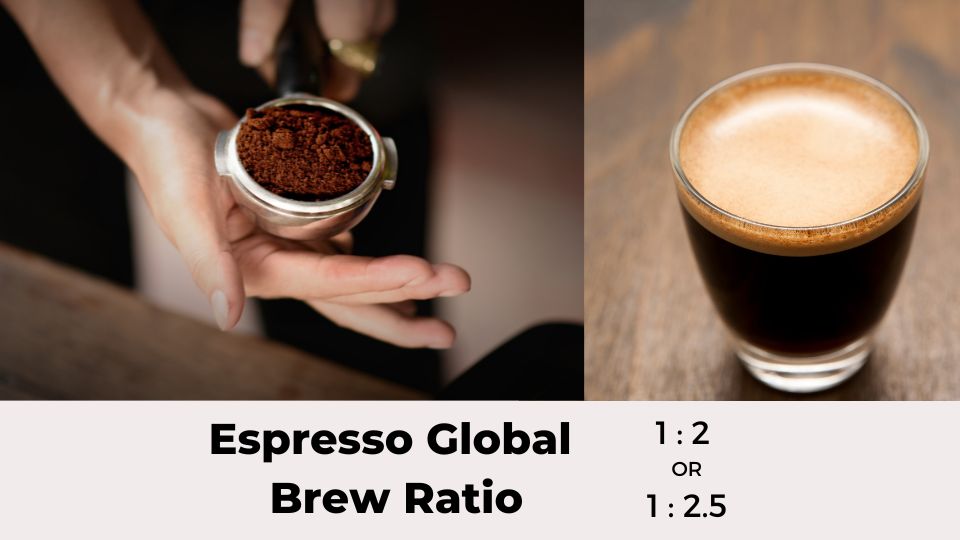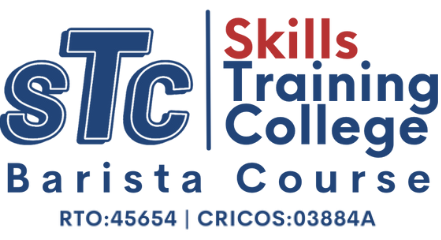Coffee beans are the cornerstone of a good espresso drink. Making an excellent shot of espresso relies heavily on the quality of the coffee beans you use. There are many different kinds of coffee beans, but espresso usually calls for a darker roast.
Dark roast coffee beans have:
- A rich, bold flavour that can withstand the intense brewing process of an espresso machine.
- They also have less acidity, which helps your shot not taste bitter.
When purchasing coffee beans, look for those labelled specifically for espresso. For the best espresso experience, these beans are typically finely ground and perfectly roasted.
To maximise the quality of coffee beans, preserving them in the best possible conditions is essential. Coffee beans should be kept in an airtight container without direct sunlight, heat, and humidity. This allows the beans to retain their flavour and aroma for longer.
What Kinds Of Coffee Beans Work For Espresso Shots?
Espresso can be made from any coffee bean. Still, the best beans for espresso have been carefully selected and roasted to bring out the specific flavours and aromas that make a good espresso.Read our short guide to coffee beans selection.
Here are some of the most popular espresso bean varieties:
- Arabica beans: Espresso is traditionally made with Arabica beans, the most popular coffee bean type. They have a delicate flavour with acidity reminiscent of fruit and are grown at high altitudes.
- Robusta beans: Robusta beans, like Arabica beans, are used to make espresso, but they have a bitter taste and a higher caffeine content. They are frequently combined with Arabica beans in blends to impart more body and crema upon the espresso shot.
- Arabica and Robusta beans combined to blend: Most espresso blends are made from a blend of Arabica and Robusta beans because this combination produces an espresso with a well-balanced flavour profile and a good crema.
- Single-origin beans: Single-origin beans are coffee beans sourced from a single region or country. These beans have been selected for their distinctive flavour profiles and can be used to make espresso shots. They may be more expensive, but they can provide an unmistakable flavour that cannot be achieved by combining ingredients.
What Needs To Be Measured To Pull The Perfect Shot?
A perfect shot requires the following adjustments or measurements:
- Dose: The quantity of coffee grounds needed to make one shot of espresso is called the dose. The dose is typically measured in grams and can vary depending on the espresso machine, the type of coffee used, and the barista’s or customer’s preferences.
A typical dose of coffee grounds for a single shot of espresso is around 7 grams. However, depending on the espresso shot’s desired flavour profile and strength, some baristas may use up to 10 grams or more. If you want to make a double shot, the normal dose of coffee grounds to use is somewhere between 16 and 18 grams.

- Yield: To maintain quality, measuring the amount of espresso drawn from the coffee grounds is important. Yield is usually measured in grams and is calculated by weighing the amount of espresso extracted from the portafilter.
- Brew Time: It is necessary to take the time necessary to determine how long it takes for the espresso to be extracted from the coffee grounds. The standard method for achieving this is timing the Shot to ensure it occurs between 20 and 30 seconds.
- Grind Size: The grind size refers to the size of the coffee grounds used in an espresso shot. The grind size is critical for obtaining the desired extraction. The coffee’s flavour will be over-extracted and bitter if the grind is too fine. Coffee will under-extract and taste weak if the grind size is too coarse.
- Water temperature: To get the best flavour from your coffee grounds, heat your water to between 195 and 205 degrees Fahrenheit (90 and 96 degrees Celsius).
- Pressure: Extraction is also affected by the pressure at which water is forced through the coffee grounds. Pressures around 9 bars are considered optimal.
To ensure consistency in the final product, measure the yield and the grind size when making an espresso shot. A barista can achieve the desired flavour profile and consistently high-quality espresso shot ml by carefully adjusting these variables.
It takes time, effort, and perseverance to become a professional barista. If you wish to advance your knowledge of espresso theory and receive practical training, you should contact an accredited training provider.
Ground Coffee – The Secret To A Great Espresso Shot
In order to make the best coffee possible, it is necessary to start with freshly roasted beans that have been ground to the appropriate coarseness. Espresso calls for a finer grind than what you’d use for a drip coffee maker.
When coffee beans are ground finely, water takes longer to circulate through them, releasing more of the bean’s aroma and flavour. This is crucial in producing the bold, full-bodied flavour for which espresso is famous.
Use a high-quality burr grinder when grinding your coffee beans to ensure an even grind. Avoid using a blade grinder, which can produce an inconsistent grind and unwanted flavours. Tailoring your grind to the machine you’re using is also critical. Since different machines require different grinds, it is critical to experiment to find the perfect consistency for your machine.
Espresso Recipe -The Art Of Making The Perfect Shot
The espresso shot can be prepared once you have the coffee beans and the coffee grounds. To get you started, here is a simple recipe:
- Preheat your espresso machine and portafilter: Before using, preheating your portafilter with hot water will ensure optimal results.
- How much coffee: A standard shot of espresso contains approximately 7-9 grams of coffee. To ensure accuracy, measure your coffee on a scale.
- Grind your coffee: Use a coffee grinder to grind the beans to a fine consistency. The grind should be uniform and neither too fine nor too coarse.
- Tamp your coffee: Place the ground coffee in the portafilter and compact it evenly with a tamper. Apply pressure to the portafilter until the coffee is firmly packed.
- Brew the espresso shot: Insert the portafilter into the machine and turn it on. The espresso shot should brew in about 25-30 seconds. The perfect espresso shot size is 1-2 ounces (30-60ml).
- Shot Time: Set a timer to ensure that the shot is brewing for the appropriate amount of time. Timing the shot will allow you to fine-tune the grind size and dosage for subsequent shots.
- Observe the crema: The layer of foam that forms on top of the espresso shot is known as the crema. A good quality espresso shot should have a thick, creamy crema that is a reddish-brown colour.
- Enjoy your espresso shot: Pour the espresso shot into a shot glass or espresso cup and serve immediately.
What Difference Does One Degree Make To An Espresso Shot?
The quality of an espresso shot can be drastically altered by as little as one degree. Shots are best served between 195 and 205 degrees Fahrenheit. However, even a few degrees off can drastically alter the flavour, aroma, and crema.
For instance, a drop in temperature of just 1-2°F (0.5-1°C) can cause under-extraction and produce a weak, sour taste. In contrast, a rise in temperature by the same value can cause over-extraction and produce a bitter, burnt taste. Therefore, producing a high-quality shot of espresso necessitates keeping water temperature consistent and precise.
What Effect Does Temperature Have On Espresso?
Temperature affects espresso in many ways, including the rate and amount of extraction, the consistency of shot quality, the texture and thickness of the crema, how it tastes, and the risk of under or over-extraction. In order to create an espresso shot that is well-balanced and full of flavour, it is essential to keep the temperature within the ideal range.
Extraction And Temperature: What Is The Ideal Water Temperature For Espresso?
In order to extract the maximum flavour from espresso beans, the water temperature should be between 195 and 205 degrees Fahrenheit. The coffee compounds are optimally extracted between these temperatures, yielding a well-rounded, flavorful shot with a thick, creamy crema.
This range is a good place to start, but the precise temperature within it can vary depending on factors like:
- The roast level of the coffee beans
- The type of machine used
- Individual preference

It’s important to try out different temperatures to find the right one for your setup and taste preferences.
The Impact Of Temperature On Individual Coffee Compounds
Temperature is critical in the extraction of individual coffee compounds. It can significantly impact the coffee’s aroma, taste, and mouthfeel. The following are some examples of how temperature affects specific coffee compounds:
| Coffee Compounds | Description |
| Caffeine | As water temperatures rise, caffeine becomes more soluble, producing higher caffeine content in the shot. However, excessive heat can cause caffeine to degrade, resulting in a bitter taste. |
| Sugars | Sugars are extracted more readily from water at higher temperatures, giving the beverage a sweeter flavour. Excessive heat, however, can result in caramelization and burnt flavours. |
| Acids | Acids are an important component of coffee, adding brightness and complexity. Higher water temperatures promote the extraction of acidic compounds, resulting in a more acidic and bright coffee. Excessive heat, conversely, can cause acid over-extraction, resulting in a sour taste. |
| Bitter compounds | Too much heat can extract bitter compounds, giving food a sharp, unpleasant flavour. |
| Oils | The extraction of oils, which contribute to the mouthfeel and body of the coffee, can be affected by temperature. Lower water temperatures can produce a lighter mouthfeel, whereas higher water temperatures can produce a fuller, heavier mouthfeel. |
How Does The Temperature Of The Espresso Brewing Affect Extraction?
There is a strong correlation between the brewing temperature and the flavour and quality of the extracted espresso. Here are some key points to consider:
- Rate of extraction: The temperature of the water influences how quickly the coffee is extracted. Cooler water takes longer to extract coffee than hot water.
- Solubility: Coffee comprises different compounds that dissolve at different temperatures. Compounds dissolve better when the temperature increases, making for a more even extraction.
- Under-extraction: If the water is too cold, the coffee won’t be extracted enough, and the resulting shot will be weak and sour.
- Over-extraction: If the water is too hot, the coffee will be pulled out too quickly, making the shot taste sharp and burnt.
- Optimal temperature range: The best temperature range for making espresso is between 195°F and 205°F (90°C and 96°C). The coffee is extracted evenly within this range, making a well-balanced and flavoured shot.
- Consistency: The water temperature must stay the same from one extraction to the next so that the quality of the shot of espresso stays the same.
- Environmental factors: The temperature and humidity of the environment can affect the water temperature, so it’s important to set the machine up correctly.
- Temperature profiling: Modern espresso machines can be programmed to change the water temperature. At the same time, the coffee is extracted to bring out certain flavours and aromas.
What Is The Global Brew Ratio?
The global brew ratio is the ratio of the weight of the espresso beverage to the weight of the coffee grounds used to prepare the beverage. It is expressed as a numerical value, such as 1:2 or 1:2.5, where the first number represents the weight of the coffee grounds used. The second number represents the weight of the espresso beverage extracted from the coffee grounds.
Espresso’s global brew ratio is typically between 1:1.5 and 1:2.5, meaning that 1.5 to 2.5 grams of espresso are extracted for every gramme of coffee. The brew ratio can vary depending on variables such as the roast level, type of coffee, and personal preference.

Does Hotter Water Produce Stronger Coffee?
Hotter water may make coffee taste stronger for the following reasons:
- Hotter water can extract more solubles from coffee, such as caffeine, oils, and acids, resulting in a higher concentration of coffee solids in the cup and a stronger flavour.
- Hotter water can expedite the extraction process, resulting in a shorter brewing time and a more concentrated and intense flavour.
- Hotter water can reduce the acidity in coffee, making it less sour and more bitter, giving it a stronger flavour.
Why Are Espresso Beverages Significantly Stronger Than Regular Coffee?
Espresso drinks are typically stronger than regular coffee because they are prepared differently, resulting in a higher concentration of coffee solids in the cup. The following justifies why espresso beverages are more potent than regular coffee:
- Espresso is made by applying high pressure to a puck of finely ground coffee compacted and heated water through it. Due to the high concentration of coffee solids and oils that are extracted during this process, the flavour is intensified and concentrated.
- Espresso is typically brewed with a higher coffee-to-water ratio than regular coffee. Espresso is typically brewed with a ratio of 1:1.5 to 1:2.5 (coffee to water), making it a more concentrated and potent beverage than regular drip coffee, which is brewed with a ratio of 1:15 to 1:18 (coffee to water).
- Espresso calls for a finer grind than regular coffee does. A finer grind lets more of the coffee’s soluble come out, making for a stronger coffee cup.
- Espresso is typically served in portions that are smaller than those of regular coffee. A standard cup of coffee weighs between 8 and 12 ounces, whereas a single espresso typically weighs between 1 and 2 ounces. Espresso has a much higher concentration of coffee solids in the cup than a regular cup of coffee due to the espresso’s smaller serving size.
How To Select The Best Coffee Grinders
Making a great shot requires using the right coffee grinder. Below are some factors to keep in mind when selecting the best coffee grinder for your espresso needs:
- Burr grinder: A burr grinder is the best type of espresso grinder because it produces consistent, uniform grounds. This is necessary for proper extraction during the brewing process.
- Burr size: The size of the burrs in the grinder is critical for achieving the right grind size for espresso. Look for burrs at least 40mm in size for the best results.
- Grind settings: Look for a grinder with various grind settings that allow you to tailor the coarseness or fineness of the grind to your specific needs.
- Doser vs. doserless: A doser grinder collects coffee grounds in a compartment, whereas a doserless grinder dispenses coffee grounds directly into a portafilter. Doserless grinders are generally thought to produce fresher grounds and eliminate the need for a dosing chamber when making espresso.
- Price: Good quality espresso grinders can be expensive, so consider your budget when selecting. Remember that investing in a high-quality grinder can significantly improve the quality of your espresso shots.
- The brand’s reputation: When shopping for a coffee grinder, look for a brand with a solid reputation for producing high-quality products.

How To Choose The Right Espresso Machine
The right espresso shot machine is key to producing the best espresso. Espresso makers can be either manually operated or fully automatic, and you can choose based on your preferences and needs.
- Manual espresso machines are trickier but give you a greater say in brewing. The extraction time, water temperature, and pressure can all be adjusted with a manual machine. You can try different approaches and hone your skills until you capture the ideal image.
- If you’re looking for a middle ground between fully manual and fully automatic machines, look no further than semi-automatic ones, which still let you regulate the water flow but take care of the rest of the work for you. Compared to a fully automatic machine, this allows for more customization during brewing.
Difference Between Espresso Shot And Fermented Coffee
The following are some distinctions between Espresso Shot and Fermented Coffee:
| Espresso Shot | Fermented Coffee | |
| Brewing method | High-pressure water forced through the finely ground coffee | Coffee beans are soaked in water to ferment for a certain period |
| Taste | Strong, concentrated flavour with a smooth, creamy texture | Complex flavours, sour and fruity notes with a more delicate body |
| Caffeine Content | Higher caffeine concentration per ounce | Lower caffeine concentration per ounce |
| Preparation Time | Quick, take only a few minutes | A longer process can take several days |
| Equipment needed | Espresso machine, grinder, tamper | Coffee maker, fermenting vessel |
What Are The 4 Qualities Of A Perfect Espresso Shot?
A perfect espresso shot has four key characteristics:
| Characteristics | Description |
| Crema | Crema is the reddish-brown foam on the espresso shot’s surface. It should be thick and creamy, with a caramel-like smell and a smooth texture. |
| Body | The body of an espresso shot is how thick and smooth it is overall. It should have a velvety feel and a full body. |
| Aroma | A good espresso shot should have a strong, pleasant aroma with hints of chocolate, caramel, and other rich, complex flavours. |
| Taste | The flavour of an espresso shot should be balanced and nuanced, with a bold, intense flavour that is neither bitter nor sour. It should be slightly sweet and have hints of fruit and nuttiness. |
How Long Should A Perfect Shot Take?
The following are the most important factors to consider when determining how long a perfect shot of espresso should take:
- A perfect espresso shot should be extracted from the machine in 20 to 30 seconds. This period allows for extracting desirable flavours and aromas from coffee beans while limiting the extraction of bitter compounds.
- Hot water is forced through a compacted puck of finely ground coffee during extraction at high pressure.
- It is essential to consistently add water to the coffee to make an espresso shot with a full, rich flavour and a thick crema.
- If the shot is extracted in less than 20 seconds, it is considered under-extracted and may taste sour and weak.
- If the shot takes over 30 seconds, it is over-extracted and may taste bitter or burnt.
- You may need to experiment with different extraction times and coffee machines to get the best flavour out of your coffee. The ultimate test of whether or not an espresso shot is “perfect” is how good it tastes.
Industry Prospects
There’s no denying that Australians love their coffee, whether they drink it at home or in a coffee shop.
Due to the average annual consumption of 1.91 kilograms per person, the country’s annual coffee market generates close to USD 5.8 billion. This points to rising coffee consumption being the primary driver of industry expansion.
Considering the industry’s rapid pace of change, highly trained baristas will be in greater demand in the years to come.

